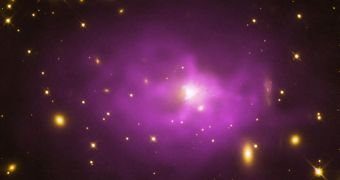Astronomers now believe that many of the biggest supermassive black holes we've discovered may actually be even bigger than thought, putting them in the ultramassive range, i.e. with masses of 10 to 40 billion suns.
Only a few of those have been discovered so far, but new data seems to suggest that scientists may have been underestimating the mass of many supermassive black holes, by an order of magnitude.
Black holes are some of the most interesting and mysterious phenomena in the universe. And, as is usually the case, the more we find out, the less we know.
Since black holes can't actually be "seen," they're detected and measured by the effects they have on surrounding matter. This means that our understanding of black holes is only as good as the indirect methods used to measure them.
Scientists are now proposing that one of the methods used to determine the weight of a black hole may be wrong, or rather, it doesn't work for very large supermassive black holes, which are a million to a billion times heavier than our sun.
Black holes can be detected in two main ways, either by observing the effect their huge gravity has on the stars nearby, or by observing the radiation emitted by matter falling towards the black holes. Incidentally, those are the two principal methods used to determine a black hole's mass.
Another method is to look at the infrared light coming from the bulge of a galaxy, which can give an indication of the mass of the black hole in the center of it.
Astronomers have used the Chandra X-ray space telescope to peer at the X-ray output from the center of 18 galaxy clusters. What they found was energy levels 10 times bigger than those predicted by looking at the infrared data, for 10 of the black holes.
This indicates that either supermassive black holes this big behave differently and emit much more energy relative to their mass than smaller black holes or that the current mass estimates are wrong.
To verify their new findings, they looked at the black hole in the center of the M87 galaxy, the central galaxy in the Virgo Cluster, specifically, at the movement of the stars near the center. Their findings supported the X-ray and radio data and suggested that these black holes are indeed about 10 times bigger than believed.

 14 DAY TRIAL //
14 DAY TRIAL //